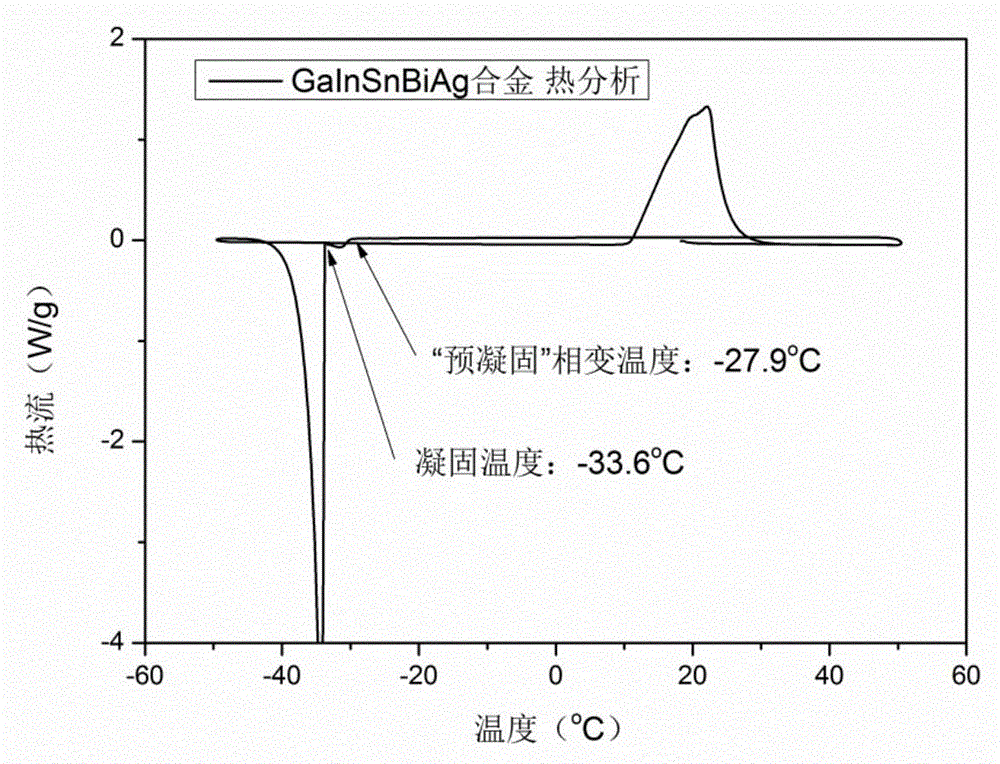Ga-based liquid alloy with low-temperature fluidity, preparation process and thermometer
A low-temperature fluidity, liquid alloy technology, used in thermometers, thermometers based on material expansion/contraction, instruments, etc., can solve problems such as difficulty in ensuring stable operation, temperature limitations of gallium-based alloys, etc., to ensure normal use and stored effect
- Summary
- Abstract
- Description
- Claims
- Application Information
AI Technical Summary
Problems solved by technology
Method used
Image
Examples
Embodiment 1
[0034] Present embodiment liquid alloy composition and proportioning (percentage by weight) are as follows:
[0035]
[0036] The preparation process is:
[0037] Gallium, indium, tin, bismuth and silver five kinds of high-purity metals (with a purity of more than 99.9%) are prepared according to the above formula requirements, and put together into a vacuum induction melting furnace (the crucible is a quartz crucible, which can avoid polluting the alloy melt ), and then vacuumize the vacuum induction melting furnace so that the pressure in the furnace is 2*10 -3 Pa; start the heating program, heat the metal mixture to 1000°C to melt all kinds of metals into a whole; at this time, reduce the heating power, refine the melted alloy at 750°C for one minute to achieve complete homogenization, and then Turn off the heating power; after cooling, the vacuum is released to take out the liquid alloy to reduce the degree of oxidation. A layer of stable oxide film is formed on the s...
Embodiment 2
[0043] Present embodiment liquid alloy composition and proportioning (percentage by weight) are as follows:
[0044]
[0045]
[0046] The preparation process is:
[0047] Gallium, indium, tin, bismuth and silver five kinds of high-purity metals (with a purity of more than 99.9%) are prepared according to the above formula requirements, and put together into a vacuum induction melting furnace (the crucible is a quartz crucible, which can avoid polluting the alloy melt ), and then vacuumize the vacuum induction melting furnace so that the pressure in the furnace is 2*10 -3 Pa; start the heating program, heat the metal mixture to 1200°C to melt all kinds of metals into a whole; at this time, reduce the heating power, refine the melted alloy at 800°C for one minute to achieve complete homogenization, and then Turn off the heating power supply; remove the vacuum and take out the liquid alloy after natural cooling.
[0048] The phase transition temperature was tested by diffe...
Embodiment 3
[0051] Present embodiment liquid alloy composition and proportioning (percentage by weight) are as follows:
[0052]
[0053] The preparation process is:
[0054] Gallium, indium, tin, bismuth and silver five kinds of high-purity metals (with a purity of more than 99.9%) are prepared according to the above formula requirements, and put together into a vacuum induction melting furnace (the crucible is a quartz crucible, which can avoid polluting the alloy melt ), and then vacuumize the vacuum induction melting furnace so that the pressure in the furnace is 2*10 -3 Pa; start the heating program, heat the metal mixture to 1150°C to melt all kinds of metals into a whole; at this time, reduce the heating power, refine the melted alloy at 750°C for one minute to achieve complete homogenization, and then Turn off the heating power supply; remove the vacuum and take out the liquid alloy after complete cooling.
[0055] The phase transition temperature was tested by differential s...
PUM
 Login to View More
Login to View More Abstract
Description
Claims
Application Information
 Login to View More
Login to View More - R&D Engineer
- R&D Manager
- IP Professional
- Industry Leading Data Capabilities
- Powerful AI technology
- Patent DNA Extraction
Browse by: Latest US Patents, China's latest patents, Technical Efficacy Thesaurus, Application Domain, Technology Topic, Popular Technical Reports.
© 2024 PatSnap. All rights reserved.Legal|Privacy policy|Modern Slavery Act Transparency Statement|Sitemap|About US| Contact US: help@patsnap.com










